Everything you need to know about a Labrador at 3 months of age

The Labrador breed is one of the most demanded and loved ones. There is a simple explanation for this - the dog has all the necessary service and wonderful personal qualities, it is friendly, cheerful, agreeable, and amenable to training. This is a cheerful and faithful assistant to a person in all matters, but in order to raise and raise a puppy, you will need to learn everything about the characteristics of the animal.
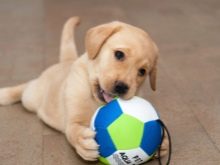
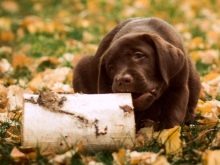

Appearance and characteristics of puppies
A Labrador puppy at 3 months looks like a rather large animal, it is already a teenager with strong legs and molars beginning to erupt, replacing milk teeth. Healthy babies have a well-nourished body, but without signs of excess weight, covered with beautiful, shiny and smooth hair.
If the puppy is purebred and healthy, then he has:
- of medium length, dense limbs;
- hanging ears;
- moderately massive head;
- flat back with strong bones;
- tucked up belly;
- uniform color throughout the body, without flaws, color and white spots;
- straight nose;
- medium width of the withers;
- sufficient distance between the back and front legs;
- Tail of moderate length.
The Labrador Retriever, which is a similar breed of hunting dog, may have a narrower, sleeker muzzle, longer and brighter coat, ranging from gold-plated to gold.
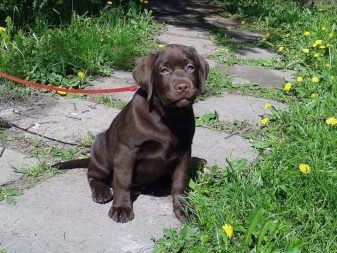
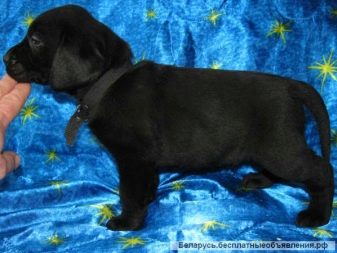
A three-month-old Labrador is active, inquisitive, reasonable balance prevails in his character, except for games, when, being carried away, he can growl and bark.
However, this is only temperament, not aggression.
Common parameters:
- growth at the withers - 40–42 cm;
- head circumference - 34–36 cm;
- chest girth - 50–56 cm;
- muzzle length - 6-7 cm;
- muzzle girth - 22-24 cm;
- mouth girth - from 11 to 11.5 cm.
At three months, the puppy should weigh about 12-14 kg, while the weight of the girls is closer to the lower limit of the standard.
The lack of pure blood in a puppy can be indicated by: a belly lowered to the ground, too long or disproportionately short limbs, clubfoot and squint, a half-erect appearance of the ears. Also, healthy young animals practically do not have dental diseases.

Proper nutrition
A three-month-old puppy taken from a breeder should be fed at first in the same way as it was before he appeared in the house. And only after a few weeks, transfer to homemade food or ready-made feed. But for this it is necessary to take into account such nuances as age, weight, the degree of daily physical activity, living conditions.
The puppy is fed 4-5 times a day, and the total amount per day should be about 400 grams.
You can choose two types of menu for your three-month-old pet.
Eating natural food, including meat, cereals, vegetables, fruits and fish. At the same time, one should not forget: in order to avoid a deficiency of important elements and vitamins, the dog will have to give various necessary supplements, liquid vitamins, calcified curd, calcium as complementary foods. You will also have to make sure that all products are of high quality and fresh. You need to cook separately for each meal, since food cannot be prepared for future use and kept in the refrigerator: this way it loses its valuable properties.

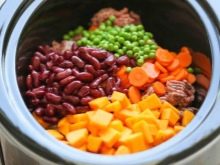
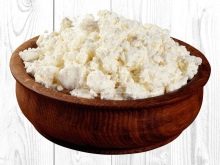
You can feed the puppy with dry food. Many people prefer this method because it is less costly, both in terms of budget and time.
But nutrition with ready-made dry granules should be prescribed by a veterinary clinic doctor. Sometimes such a measure is necessary if the animal's stomach is highly sensitive to many natural products, or if the dog has a tendency to display allergies.
Modern industrial food of well-known brands can provide a pet with high-quality, impeccably balanced food, while premium food provides special holistic, anti-allergenic products that are suitable for dogs with individual digestive characteristics.
Some owners choose a mixed type of food for their pet, according to the rules of which the dog receives dry food in the morning and eats natural food in the evening. However, this method of feeding is suitable only for temporary use: it is undesirable a priori to mix homemade products and dry food.

Homemade food
Already from day 40, puppies from liquid cereals and dry granules soaked in water are transferred to full-fledged natural nutrition.
A dog in 3 months needs the following foods in the diet:
- the healthiest meat for a young animal - raw lean beef, rich in animal proteins and is a building material for the normal development of the body;
- sea fish rich in phosphorus, proteins and iodine, - given to puppies at 3 months only in boiled form;
- cottage cheese, kefir, yogurt and milk Needed for optimal digestion and gut health
- in a small amount, the dog requires the use of cereals - mainly buckwheat and rice.
Also, in porridge with meat and in meat broth, you need to add finely chopped greens, raw vegetables: pumpkin, cabbage, zucchini and carrots. A minimum of salt is allowed when cooking. In addition, the animal needs clean water that is constantly available.
The following foods should be avoided: bones, especially boiled ones, wheat bread, sausages and sausages, fatty meats, sweets.
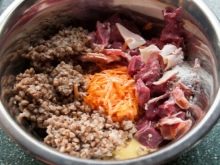
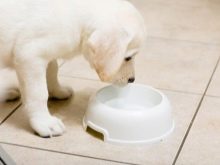
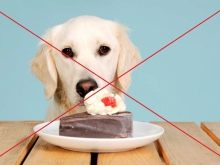
Upbringing
From childhood, the puppy must be taught to the correct dog manners. At three months he should know commands such as "Place", "Fu", "Sit", "Lie down".
First of all, the baby brought to the house should be introduced to the place where he will sleep and rest, with his dishes for eating and drinking.For the bed, they choose a place that is warm and cozy, so that the puppy gets used to it faster, they put toys there by age and treats, for example, a sugar bone.
An important point is collar training. As soon as the puppy is comfortable in the house, you can put on a dog accessory and immediately reward him with some kind of treat.
To raise a boy correctly means to wean him from gnawing things, picking up food from the ground, barking at people and showing aggression towards other animals, as well as teaching him to meet the owner without rushing at him with a joyful roar - for this the puppy must execute the command "Place" or "Sit".
Even if an animal has done something, you should never punish it if it lies on its back with an open belly. In addition, as the rule states, the dog must be on a short leash when punishing.
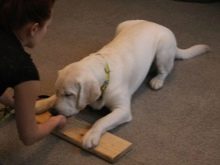

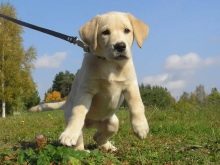
However, inexperienced owners often make mistakes during training that can negatively affect the physical health and psyche of the puppy:
- use beatings during training;
- accompany dissatisfaction with the dog's behavior with obscene language in an angry tone;
- give unbearable instructions and tasks to the animal that do not correspond to its strength and age.
It is also not necessary to train the Labrador in security activities, since this is not his purpose.
Maintenance and care
Caring for a young dog has its own characteristics, and you need to know about them, since the health of the pet depends on it.
- Once a week the puppy needs to clean his ears with a special veterinary lotion, but this should be done with a soft damp cloth.
- Every 2-3 months the animal is washed with zoo shampoo, it is not recommended to bathe more often, as this can provoke skin diseases.
- The puppy is 3 months old with the growth of the molar tooth, the milk one can still remain in place. In this case, you need to consult a doctor to remove it. For prevention purposes, the dog should be periodically treated with raw potatoes and carrots to prevent the formation of plaque and tartar.
- Puppy claws are cut 2 times a month, later the animal will grind them down during long walks.
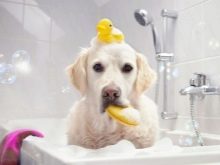

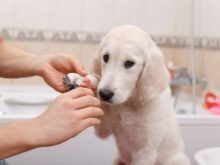
If the puppy hasn't been vaccinated yet, it's time to do it. And do not forget that you need to walk and play a lot with the dog in the fresh air. So it grows faster, fully develops and builds muscle mass. It's good if a little Labrador makes friends with other dogs - nothing has such a positive effect on the mental health and socialization of an animal as communicating with others like them. However, other animals can also become friends of the puppy, the main thing is to teach him to treat them not as enemies or prey.
A list of all the necessary things and items that a Labrador needs for a normal life can be found in the video below.







































Everything is cool! Thanks!